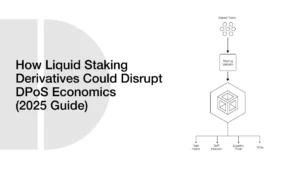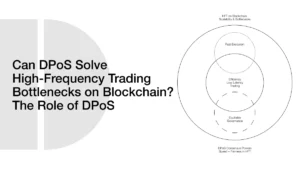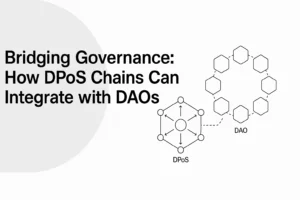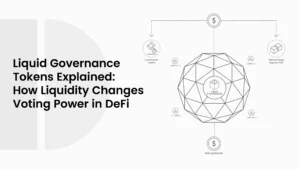How Generative AI Could Simplify DPoS Codebase Maintenance
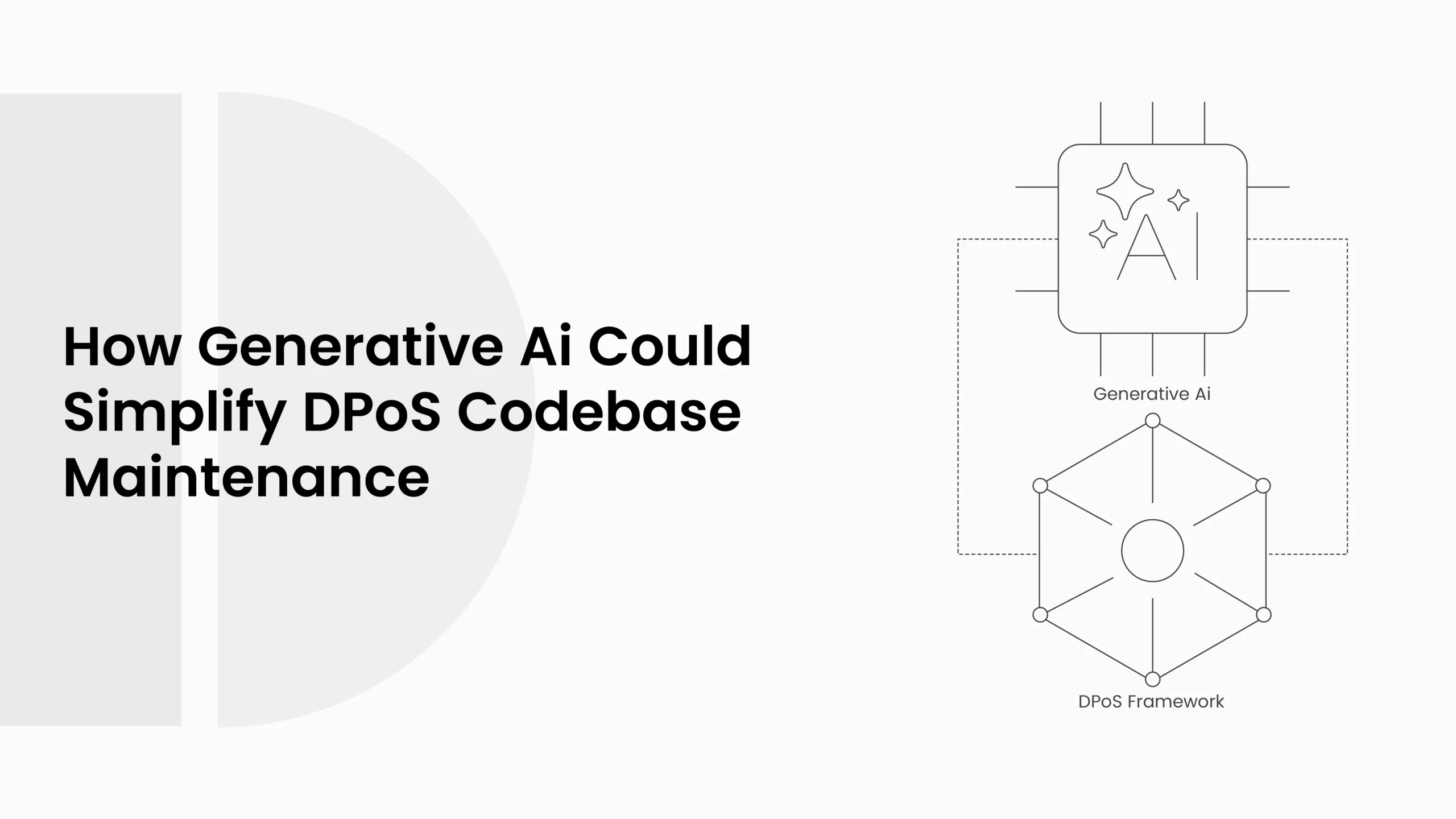
Delegated Proof of Stake, or DPoS, is one of the most common methods by which blockchains come to consensus about which transactions are valid. It is quicker and less expensive than older protocols such as Proof of Work, and there is one major challenge with it. The computer code of a DPoS network can become extremely complicated. Bugs become difficult to maintain when new features are added, bugs fixed, or a system is upgraded. The developers must dedicate a significant amount of time to reviewing, fixing, and cleaning the code to ensure the network continues to operate efficiently.
- What Is DPoS, and Why Does Its Codebase Matter?
- Understanding DPoS in Easy Terms
- Why the Codebase Gets Complex Over Time
- Why Codebase Maintenance Matters for DPoS
- Challenges in Maintaining a DPoS Codebase
- Common Issues Developers Face
- Risks of Manual Maintenance
- The Pressure on DPoS Networks
- Manual vs Automated Maintenance in DPoS
- How Generative AI Can Simplify Codebase Maintenance
- Automating Refactoring
- Improving Documentation
- Detecting and Preventing Errors
- Benefits of Generative AI in DPoS Code Maintenance
- Real-World Use Cases of AI in Blockchain Codebases
- AI in Smart Contract Debugging
- AI for Governance Code Updates
- AI for Network Performance Optimization
- Comparing Popular Generative AI Tools for Developers
- GitHub Copilot and DPoS Codebases
- OpenAI Codex and Automated Testing
- Zencoder and Large-Scale Blockchain Projects
- Generative AI Tools and Their Role in DPoS Maintenance
- How AI Balances Code Maintenance and Ongoing Development
- Preventing Delays in Feature Releases
- Enforcing Coding Standards Across Teams
- Lowering Developer Burnout
- The Future of Generative AI in DPoS Development
- AI-Driven Autonomous Maintenance
- Cross-Language Refactoring for Multi-Chain Projects
- Integration with CI/CD Pipelines
- Future Trends of AI in Blockchain Code Maintenance
- Conclusion
- Frequently Asked Questions About How Generative AI Could Simplify DPoS Codebase Maintenance
- What is codebase maintenance in DPoS?
- How can AI help developers working on DPoS?
- What are the risks of not maintaining a blockchain codebase?
- Which AI tools are best for blockchain code refactoring?
- Will AI fully replace developers in DPoS networks?
- Glossary of Key Terms
This is where generative AI comes in. Generative AI is a form of artificial intelligence that can train on existing data and then generate novel content. In software development, it can write new code, improve old code, or even explain what a portion of code is doing. In the case of DPoS networks, this implies that developers can be provided with assistance in challenging tasks, such as refactoring, documentation, and debugging, with the help of AI. Rather than reviewing the code manually, which can take several hours, developers can use AI tools to help accelerate the process and minimize human error.
Blockchain codebase maintenance is not only a process for fixing mistakes. It is also about ensuring the system can be easily expanded in the future. Not well-maintained code will either slow performance, create security problems, or make it more difficult to add features. With generative AI, developers will be able to maintain DPoS codebases that are clean, efficient, and scale-ready. This makes the network more stable for users and simplifies developers’ lives.
In this blog, we will explore how generative AI can simplify the maintenance of DPoS codebases. We will examine the challenges of manual maintenance, explore how AI can address them, review the tools available today, and consider what the future may hold. By the end, you will see why AI is becoming an essential partner in blockchain development.
What Is DPoS, and Why Does Its Codebase Matter?
Understanding DPoS in Easy Terms
A system adopted by blockchains to agree on transactions is known as Delegated Proof of Stake (DPoS). The simple way to put it is that it is a kind of voting system. Those with tokens in a blockchain have access to voting for a select number of delegates. These representatives verify transactions, generate new blocks of transactions, and ensure the network remains secure.
The main advantage of DPoS is speed. Since only a few delegates are making decisions at a time, the network can process transactions much faster than older systems, such as Proof of Work (used by Bitcoin). It also uses much less energy, making it a greener choice for blockchains.
But the system depends heavily on code. The rules for voting, block creation, and rewards are all written in software. If the code is unclear or contains bugs, the entire network can face problems. That is why the DPoS codebase must be maintained carefully.
ALSO READ: How Green Bonds Could Be Managed Using DPoS Chains
Why the Codebase Gets Complex Over Time
The codebase of a blockchain can be simple when it is just beginning. With time, developers will implement new features, fix bugs, or modify the rules to enhance security. All these additions complicate the code and increase its size.
The other problem is that there is a possibility that numerous developers may be working on the same codebase. Others enhance performance or security, whereas others concentrate on the rules of governance. The updates might get sloppy unless they are managed properly. It is referred to as technical debt. Technical debt, like financial debt, requires more effort and is costly to the work in the future.
DPoS networks also proliferate due to their increasing popularity. Many projects utilizing DPoS attempt to attract users with new features such as smart contracts, staking rewards, or faster block times. Each new feature adds more code that must be tested and maintained. Without proper care, the risk of bugs or performance issues increases.
Why Codebase Maintenance Matters for DPoS
Maintaining the code involves not only correcting issues but also addressing other aspects. It is also regarding maintaining the network in readiness. Otherwise, the blockchain can be unstable, slow, or unsafe if developers neglect to keep the code up to date. This may lead holders of tokens to lose trust in the system.
To illustrate, a flaw in the voting system may remain unresolved, thereby enabling a representative to become overly powerful. Or when the old code slows down performance, users might abandon the network in favor of faster alternatives. These concerns demonstrate the importance of code maintenance to the well-being of the DPoS blockchains.
Generative AI can help by making code maintenance easier, faster, and more reliable. Instead of spending weeks cleaning and testing code, developers can use AI tools to handle the heavy work. This enables them to focus on developing new features while maintaining system stability.
Challenges in Maintaining a DPoS Codebase
Maintaining the code of a Delegated Proof of Stake (DPoS) network is not an easy task. It requires constant updates and thorough technical checks, as well as close attention to detail. The system is decentralized and has numerous moving components, so that a simple error can result in significant problems throughout the entire system.
Common Issues Developers Face
A key issue of DPoS maintenance is error debugging. Since the network relies on many validators and delegates, an error in one part of the code may impact the way blocks are produced or votes are counted. These mistakes are highly time-consuming, requiring hours of manual checks and inspections.
Another problem is outdated or inadequate documentation. Late developers may not understand the actual reason why some code was written in a particular manner or way. In the absence of clear records, they waste more time attempting to make out the logic as opposed to making it better.
A third problem is the need to balance upgrades with network stability. Developers want to add new features to keep the blockchain competitive, but they must also ensure the upgrades do not break the existing system. In a live blockchain, there is no room for mistakes because users depend on it every second.
Risks of Manual Maintenance
When code maintenance is done manually, several risks appear. One risk is the increased likelihood of introducing new bugs while fixing existing ones. Developers might change one part of the code without realizing it affects another part.
Another risk is time consumption. Manual refactoring and testing can take weeks or even months to complete. During this time, other improvements may be delayed, which slows the project’s growth.
Finally, manual maintenance often increases costs. Developers require more hours to complete tasks, resulting in increased expenses for routine work rather than innovation. For open-source blockchain projects, this can limit progress and discourage contributors.
The Pressure on DPoS Networks
Due to the design of DPoS networks, which are intended to be fast and scalable, their codebases undergo rigorous stress testing. Users are demanding low charges and fast transactions, but this can only happen when the code behind runs smoothly. The code will constitute a bottleneck when it is difficult to maintain and update. This bottleneck delays innovation, reduces network performance, and erodes the trust of token holders.
Generative AI can help solve these problems by automating some of the most time-consuming tasks. However, before we examine how AI aids, let’s compare manual maintenance with automated maintenance.
Manual vs Automated Maintenance in DPoS
| Factor | Manual Maintenance | Automated Maintenance with AI |
| Speed | Slow, requires long hours of coding and testing | Fast, AI tools can scan and refactor code in minutes |
| Accuracy | Prone to human error, missing hidden bugs | High accuracy with pattern recognition and predictive checks |
| Scalability | Difficult to maintain as the codebase grows | Can handle large and complex codebases efficiently |
| Cost | Higher developer costs due to the time spent | Lower cost since repetitive tasks are automated |
| Developer Stress | High, repetitive debugging leads to burnout | Low, AI reduces workload so developers focus on innovation |
How Generative AI Can Simplify Codebase Maintenance
Delegated Proof of Stake (DPoS) is a type of complex system whose upkeep is altered by generative AI. Rather than take weeks to perform manual work, developers can now automate refactoring, enhance documentation, and even detect errors before they lead to problematic situations. It renders blockchain networks more stable and allows developers to work stress-free, much faster.
ALSO READ: What is the Role of Dynamic Inflation in Long-Term DPoS Stability?
Automating Refactoring
Refactoring is the process of cleaning up old code without altering its behavior. Refactoring is of high importance in DPoS networks since the code changes frequently. Over time, messy quick fixes, upgrades, and new features can make the code more difficult to comprehend.
Generative AI can search through large codebases and identify regions that require cleaning. It is able to propose alternative solutions for writing functions, simplifying complex logic, and eliminating repeated code. Rather than recreating everything manually, developers can take suggestions from AI and refactor more quickly. This saves time and reduces the risk of introducing new bugs.
For example, if a voting function in DPoS has outdated loops or heavy computations, AI can recommend a more efficient version. This means the system runs smoothly while still producing the same results.
Improving Documentation
Good code is as essential as good documentation. Without it, new programmers may struggle with the system. Documentation in most DPoS projects is lagging, as developers concentrate on immediate solutions rather than creating clear documentation.
The gap can be addressed with generative AI, which can automatically produce documentation. It has the ability to read code, describe what each function does, and write in human-friendly language. This assists new developers in coming up to speed easily and saves time on the need to understand old logic.
Imagine a new developer joining a DPoS project. Instead of spending days decoding a voting algorithm, they can read AI-generated documentation that explains the logic step-by-step. This makes teamwork easier and helps projects grow faster.
Detecting and Preventing Errors
One of the biggest fears in maintaining DPoS code is introducing new bugs. A small error in the delegate voting system or block validation process can affect the entire blockchain. Manual debugging is slow and often misses hidden issues.
Generative AI can act as a safety net. By analyzing code in real time, it can highlight risky areas and suggest fixes before deployment. AI can also run automated tests, predicting where errors may appear after changes are made.
This proactive approach saves developers from emergencies and maintains the blockchain’s stability. Instead of reacting to problems after they happen, teams can prevent them from happening in the first place.
Benefits of Generative AI in DPoS Code Maintenance
| Aspect | Before AI (Manual) | After AI (With Generative AI) |
| Refactoring | Slow, error-prone manual rewrites | Faster, AI suggests clean and optimized code |
| Documentation | Often missing or outdated | AI generates clear, up-to-date explanations |
| Error Detection | Bugs found late during testing | AI predicts and prevents bugs early |
| Developer Efficiency | High workload and stress | Developers focus on innovation, with less burnout |
| Network Stability | At risk due to hidden issues | More stable due to proactive maintenance |
Real-World Use Cases of AI in Blockchain Codebases
Generative AI is not just a theory; it’s a reality. Developers are already using it in real blockchain projects. These use cases demonstrate how AI can enhance the stability, security, and maintainability of DPoS systems.
AI in Smart Contract Debugging
Smart contracts are small programs that operate on blockchains. In DPoS networks, they tend to dictate aspects such as token transfers, staking rewards, and governance rules. One bug in a smart contract can result in loss of money or unfair voting.
The use of Generative AI assists in scanning smart contracts and identifying vulnerabilities. It can propose fixes, point out insecure code, and even create safer versions. For example, if a smart contract fails to verify the overflow of mathematical operations, AI can identify this issue and suggest a more secure version. This enhances the quality of contracts and eliminates the risk of costly mistakes.
AI for Governance Code Updates
One of the unique features of DPoS is governance. Token holders vote for delegates, and the rules for this voting are written in the codebase. Updating governance code is a sensitive job because it affects how power is shared across the network.
AI can simplify this process by reviewing governance logic and suggesting safer ways to implement changes. For example, if a blockchain needs to update the number of active delegates, AI can help adjust the code while ensuring that old rules still function correctly. This saves time and reduces the likelihood of system failure.
AI for Network Performance Optimization
DPoS networks rely on performance as they are said to be faster than older blockchains. However, as the codebase increases, performance may decrease. Bottlenecks are observed in the processing of transactions, block validation, or memory consumption.
These bottlenecks can be located by analyzing the code with generative AI. It can suggest ways to improve it, including minimizing heavy loops or redesigning data storage. In other instances, AI can even recode certain sections of the code to enable faster execution. That makes the blockchain scalable and capable of accommodating additional users.
ALSO READ: Can DPoS Solve High-Frequency Trading Bottlenecks on Blockchain?
Comparing Popular Generative AI Tools for Developers
Generative AI tools are already helping developers across various industries, and many of them can be applied to blockchain projects, such as DPoS. Each tool has its own strengths, and knowing how they work can help developers choose the right one for codebase maintenance.
GitHub Copilot and DPoS Codebases
GitHub Copilot is one of the most well-known AI coding assistants. It can suggest code snippets, entire functions, or even explain logic. For DPoS developers, this means that repetitive coding tasks, such as writing voting logic or updating delegate functions, can be sped up. Copilot can also suggest more efficient ways to write code, reducing the time required for manual refactoring.
For example, if a delegate selection function is too complex, Copilot can suggest a cleaner and more efficient version. This not only saves time but also makes the code easier for future developers to understand.
OpenAI Codex and Automated Testing
OpenAI’s Codex powers Copilot but can also be used directly for broader tasks. One area where Codex shines is automated testing. DPoS networks rely heavily on test cases to ensure stability. Writing these tests manually is time-consuming.
Codex can generate test scripts that check for edge cases, such as what happens if a delegate misses multiple blocks or if voting deadlines are not met. By automating testing, Codex helps developers catch issues before they reach the live network.
Zencoder and Large-Scale Blockchain Projects
Zencoder is designed for large and complex codebases, making it useful for enterprise-level blockchain projects. Many DPoS systems run across multiple languages and modules, which makes maintenance difficult. Zencoder uses machine learning to handle cross-language refactoring and can even generate documentation automatically.
For example, in a multi-chain project where some code is written in Rust and some in C++, Zencoder can analyze both and suggest improvements that maintain consistency across all code. This is a big advantage for DPoS projects trying to scale.
Generative AI Tools and Their Role in DPoS Maintenance
| Tool | Best Use Case in DPoS Maintenance | Key Features |
| GitHub Copilot | Writing and refactoring repetitive code | Code suggestions, faster coding |
| OpenAI Codex | Generating automated test cases | Handles edge cases, test automation |
| Zencoder | Managing large, multi-language codebases | Cross-language refactoring, documentation generation |
These tools demonstrate that generative AI is not just about writing new code; it is also about maintaining existing codebases as clean, secure, and future-ready as possible. For DPoS networks, where code quality directly affects network trust and performance, using the right AI tool can make all the difference.
How AI Balances Code Maintenance and Ongoing Development
In DPoS networks, developers face a constant challenge. They must maintain a clean and secure codebase, but also need to add new features to keep the blockchain competitive. This creates a tension between fixing what already exists and building what comes next. Generative AI helps balance these two goals so that progress does not stop.
Preventing Delays in Feature Releases
One of the most significant issues with manual maintenance is the time required. Developers often need to pause feature development to focus on cleaning the code. This slows down the release of new updates, making the blockchain less attractive to users.
Generative AI reduces these delays by targeting only the most critical areas of the code. Instead of rewriting entire modules, AI can pinpoint the specific functions that require attention. This incremental approach saves time and allows teams to release new features while still improving the codebase.
For example, if developers want to launch a new staking feature but the old delegate module is messy, AI can clean only the necessary parts without forcing a full rewrite. This keeps both innovation and stability moving forward.
Enforcing Coding Standards Across Teams
Large DPoS projects usually have developers from different backgrounds. Each person may write code in their own style, which makes the codebase harder to maintain. Without common standards, the project risks becoming inconsistent and confusing.
Generative AI helps by suggesting code that follows established best practices. It can also review contributions in real time and point out where style rules are not being followed. This creates a more consistent codebase, making maintenance easier in the long run.
Imagine a team where one developer writes long functions and another prefers shorter ones. AI can suggest breaking down large functions to match the project’s style, keeping everything uniform.
Lowering Developer Burnout
Maintaining a complex DPoS system can be a stressful task. Developers spend hours fixing bugs, reviewing code, and writing documentation. Over time, this repetitive work can lead to burnout, resulting in reduced motivation and productivity.
Generative AI is increasingly taking over many of these repetitive tasks. It can generate documentation, suggest fixes, and even run automated tests. This reduces the workload on human developers, allowing them to focus on creative tasks, such as designing new features or enhancing user experience. With less stress, teams can work more effectively and stay motivated for longer.
The Future of Generative AI in DPoS Development
Generative AI is still relatively new, but its role in blockchain development is rapidly expanding. As tools become smarter, they will not just help with maintenance; they will take on a bigger role in running and improving entire DPoS networks.
AI-Driven Autonomous Maintenance
In the future, AI can handle maintenance tasks with minimal human input. Instead of waiting for developers to fix bugs, the system itself could detect problems and correct them automatically. For example, if the voting module has a small bug, AI could rewrite the function, test it, and push the update without slowing down the network.
This type of self-healing codebase could make DPoS networks far more stable. Developers would act more like supervisors, checking the AI’s work rather than doing every task manually.
Cross-Language Refactoring for Multi-Chain Projects
Many blockchain projects now use multiple programming languages. A DPoS project might have core code written in C++, smart contracts implemented in Rust, and APIs developed in Python. Maintaining such a mixed codebase is very difficult.
Generative AI could bridge this gap by analyzing all languages at once. It can identify errors across them, suggest cross-language improvements, and maintain consistency. This would make multi-chain and cross-platform projects much easier to scale.
Integration with CI/CD Pipelines
CI/CD (Continuous Integration and Continuous Deployment) pipelines are systems that automate the testing and deployment of code. Today, humans still need to review and approve many steps. With generative AI, CI/CD could become fully automated.
Imagine a future where a developer submits new governance rules for a DPoS network. AI can instantly review the code, run security checks, and refactor where needed, then push the update to production. This would enable faster, safer, and more reliable upgrades.
Future Trends of AI in Blockchain Code Maintenance
| Future Trend | What It Means for DPoS Developers | Benefits for the Network |
| Autonomous Maintenance | AI fixes bugs and refactors code on its own | Less downtime, more stable codebase |
| Cross-Language Refactoring | Handles C++, Rust, Python, and more together | Easier scaling for multi-chain projects |
| AI in CI/CD Pipelines | Fully automated testing and deployments | Faster updates, fewer human errors |
| Smarter AI Models | Context-aware code suggestions | Cleaner code and stronger security |
Generative AI will not replace developers, but it will change their role. Instead of spending hours fixing bugs or writing documentation, they will guide AI systems and focus on creative innovation. This partnership will make DPoS networks more efficient and future-ready.
ALSO READ: How DPoS Can Reshape Mobility Governance with Mobility-as-a-Service (MaaS)?
Conclusion
Delegated Proof of Stake (DPoS) is a powerful system for running fast, scalable blockchains. However, keeping its codebase clean and secure is a significant challenge. Without proper maintenance, networks risk slowing down, becoming unstable, or losing user trust. Traditionally, this maintenance has been done by developers working long hours to refactor code, write documentation, and fix bugs.
Generative AI changes this picture. With AI tools, developers can refactor code more efficiently, generate clear documentation, and identify bugs before they cause issues. AI balances ongoing development with maintenance, helping teams release new features without delaying upgrades. It also reduces developer burnout, enhances collaboration, and fosters more stable blockchains.
Looking ahead, AI could even take on autonomous maintenance, handle cross-language projects, and fully integrate into CI/CD pipelines. This future will not remove the need for human developers but will give them more time to focus on innovation instead of routine tasks.
The lesson is simple: Generative AI makes DPoS codebase maintenance easier, faster, and safer. For blockchain projects that want to grow, adopting AI is no longer just an option; it’s the smart move.
Frequently Asked Questions About How Generative AI Could Simplify DPoS Codebase Maintenance
What is codebase maintenance in DPoS?
Codebase maintenance refers to the process of cleaning, updating, and improving the software that powers a DPoS blockchain. It ensures the network stays secure, fast, and ready for new features.
How can AI help developers working on DPoS?
AI can automate refactoring, generate documentation, and detect errors early. This saves time and reduces the chances of bugs slowing down the network.
What are the risks of not maintaining a blockchain codebase?
Without maintenance, the code can become slow, buggy, or insecure. This may lead to user trust issues, poor performance, or even network failure.
Which AI tools are best for blockchain code refactoring?
Popular tools include GitHub Copilot for code suggestions, OpenAI Codex for automated testing, and Zencoder for managing large, multi-language projects.
Will AI fully replace developers in DPoS networks?
No, AI will not replace developers. Instead, it will act as a partner. Developers will guide AI, focus on creativity, and ensure that the blockchain runs smoothly.
Glossary of Key Terms
- DPoS (Delegated Proof of Stake): A blockchain method where token holders vote for delegates who validate transactions.
- Codebase Maintenance: The ongoing process of cleaning, improving, and updating software code.
- Refactoring: Rewriting code to make it cleaner and easier to maintain without changing what it does.
- Technical Debt: Problems caused when developers take shortcuts in coding, making future changes harder.
- CI/CD Pipelines: Automated systems that test and deploy new code into production.

